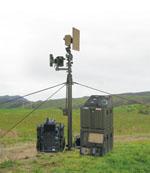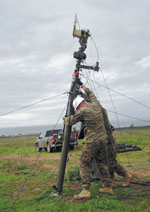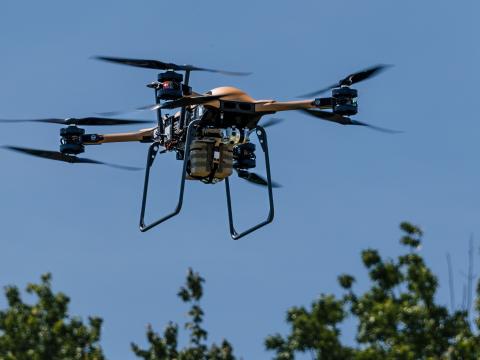Tactical System Connects Units
 |
| The U.S. Marine Corps is providing the wireless point-to-point link (WPPL) system to its deployed forces. WPPL features secure point-to-point line-of-sight or non-line-of-sight transmissions for voice, data and video communications. |
The U.S. Marine Corps is issuing a new tactical communications system to deployed and expeditionary forces. This equipment provides forward positions such as operating bases, checkpoints and command posts with reliable, high-bandwidth connectivity to receive and send video, voice and data transmissions. This new tool is being used to link widely dispersed units across
Units involved in counterinsurgency and humanitarian missions often are scattered across wide areas with little support. Modern sensor and communications technologies have greatly improved the situational awareness and effectiveness of
The wireless point-to-point link (WPPL) system provides the secure point-to-point line-of-sight or non-line-of-sight transmission of voice, data and video communications. The Marine Corps has developed WPPL, built by TeleCommunication Systems Incorporated (TCS),
Besides providing voice, video and data communications, WPPL can channel classified and unclassified networks, voice over Internet protocol and defense switched network (DSN) services. WPPL consists of commercial components integrated into a military-grade system. The major describes the system as more hardware-based than software-based, although some components are software-driven.
WPPL was developed to meet Marine Corps requirements for a small, lightweight, easily transportable communications system capable of providing on-the-pause data communications to remote sites. Maj. Cornell explains that this was a pressing need because the Marine Corps’ existing terrestrial systems were large, unwieldy and strictly line-of-sight. He adds that there was a need for a deployable system with a small footprint that could pass data in non-line-of-sight conditions.
The core WPPL equipment consists of Redline and Harris radios, and adjustable 35-foot masts for line-of-sight Internet protocol transmissions. Each system breaks down into six transit cases that can be carried by two soldiers and transported by a single high-mobility multipurpose wheeled vehicle (HMMWV). Maj. Cornell states that a fully assembled WPPL system weighs about 850 pounds. The six-case package includes all of the operational equipment and spares. Trained personnel can assemble a WPPL system in 30 minutes, he says.
WPPL uses standard network interfaces. This allows any number of devices capable of converting analog voice data from a single-channel radio to hook up and convert to Internet protocol. Maj. Cornell notes that WPPL itself does not have the devices and software to make this transition, but these systems can be integrated easily into WPPL. WPPL features interfaces for laptop computers, Cisco voice over IP telephones and devices using RJ45 interfaces.
Although it has operated at the platoon level, WPPL-D originally was intended to support forces at the battalion level. The original concept for deploying the system was to provide communications from a regiment down to a battalion command post. However, the major notes that once the system was deployed, Marines began to extend services from battalion command posts down to company headquarters.
 |
| Unlike legacy terrestrial point-to-point communications systems, WPPL will be easy to transport and deploy. The system breaks down into six manportable shipping cases and can be assembled within 30 minutes. |
Another reason WPPL is popular is its reliability, Maj. Cornell admits. Once WPPL has been installed and data is transmitted over the link, the system is very resistant to breakdowns. “It doesn’t require a lot of care and feeding once that link is in,” he says. The major notes that this ease of use is a major contrast to the service’s legacy terrestrial systems, which require high levels of support and teams of skilled operators to maintain communications links. Although they have been upgraded, the major explains that many legacy terrestrial systems are based on technology that is more than 20 years old. He adds that the Marine Corps is moving to modernize its terrestrial systems, but it has not yet deployed any new technologies.
WPPL’s beyond-line-of-sight capability is important in
Although the system can run important battlefield applications such as live streaming video, Maj. Cornell cautions that a number of factors determine the data rate of a WPPL link. These factors include the distance between antennas, how high the antennas are and if there are any obstacles. If two systems are within 10 to 15 miles of each other, the link will be in the area of 54 megabits per second. “Fifty-four megabits per second is more than enough to support streaming video feeds and many data bandwidth-intense applications. As you get past 15 miles and move out to 20 or 25 miles, the data rate begins to drop,” the major maintains.
Maj. Cornell shares that some WPPL links in
WPPL is in the middle of its fielding phase with the new WPPL-D systems being delivered to operating forces. Because of the delivery process, no new development road maps are currently in place as the program is focused on deploying the current inventory. However, once this deployment is complete, the major says the Marine Corps will examine future development possibilities.
The Marine Corps also has decided to make WPPL a program of record, which means that it will become a permanent part of the service’s inventory with its own budget and funding. “That doesn’t mean that it won’t transform and evolve into something different. But the technology—the capability—we’re going to keep around for years to come,” Maj. Cornell says.
Some 236 WPPL systems have been acquired in several orders. The first WPPL purchase was for 30 systems for all Marine Expeditionary units. A second purchase designated 50 systems for Marine forces operating in
Web Resources
TeleCommunication Systems Incorporated: www.telecomsys.com



Comments